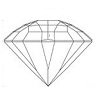16.4.12: Pezzottaite
- Page ID
- 4084
| Pezzotaite | |
|---|---|
| Chemical composition | Cesium Beryllium Lithium Aluminium Silicate Cs(Be2Li)Al2Si6O18 |
| Crystal system | Trigonal |
| Habit | subhedral-to-euhedral hexagonal tabular |
| Cleavage | imperfect (basal) |
| Fracture | conchoidal to irregular |
| Hardness | 8 |
| Optic nature | uniaxial - |
| Refractive index | 1.601-1.620 |
| Birefringence | 0.011 |
| Dispersion | unknown |
| Specific gravity | 3.04-3.14 |
| Lustre | vitreous |
| Pleochroism | moderate to strong |
| Pezzottaite image gallery |
Pezzottaite is a raspberry-red to pink member of the Beryl Group named after Dr. Federico Pezzotta. Discovered in Madagascar and IMA approved in 2003 as a new mineral.
Although related to Beryl it is not a variety of Beryl, it is a gem quality member of the Beryl Group to which also Beryl belongs.
Crystallography
Pezzottaite has trigonal symmetry. Pezzottaite with Cs and Li is not isostructural with beryl but the arrangement is close. Pinacoid, prism, pyramid are common forms. Etching and corrosion is seen.
Chemical composition
Composition with trace elements: Pezzottaite is Cs(Be2Li)Al2Si6O18 ; i.e. Cs, Li rich beryl. In Beryl three Be atoms as in formula occupy three symmetrical positions but in pezzottaite, the three positions are occupied in an ordered pattern by Be2Li rather than Be3. Thus these positions are not related by symmetry and changes to 3-fold symmetry rather than hexagonal and larger unit cells. This increase has an effect on the properties to a great extent. Other important traces include Rb, Na, Mn, K, Sc, Ti, Fe also.
Beryl: Be3Al2Si6O18
Pezzottaite: Cs(Be2Li)Al2Si6O18
Diagnostics
Color
Due to radiation induced color center involving Mn3+; Purplish pink, sometimes orangish tinge present (Madagascar).
Magnification
Inclusions: Growth tubes, fractures, fingerprint and fluid inclusions with phase. Transparent near colorless crystals. Also transparent green crystals of tourmaline. Rarely color zoning.
Phenomena
Cat's eye
Treatments
Fracture filling with oil or resin.
Heat may lighten color and irradiation darken it.
Simulants
- Morganite (lower heft, lower R.I)
- Tourmaline (Doubling of inclusions & Back facet edges, Higher birefringence)
- Tourmaline cat's eye is very close to pezzottaite cat's eye (Birefringence blink and inclusions)
Occurrence
Geological occurrence: Granitic pegmatites having Li, Cs, Ta and other rare Earth elements. Mainly crystallized from the fluids in the cavities as late-stage crystals.
Geographical occurrence: Sakavalana pegmatite in Madagascar; little in Afghanistan too and sometimes in other granitic pegmatites.
Sources
- Gems and Gemology 2003 - GIA
- Journal of Gemmology - Gem-A
External links
- Pezzottaite
- Pezzottaïte: "Béryl" rose-pourpre atypique riche en Césium de Madagascar (in French)


